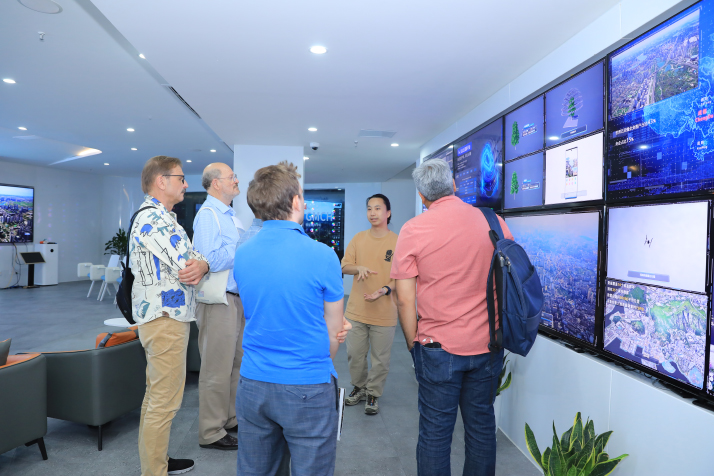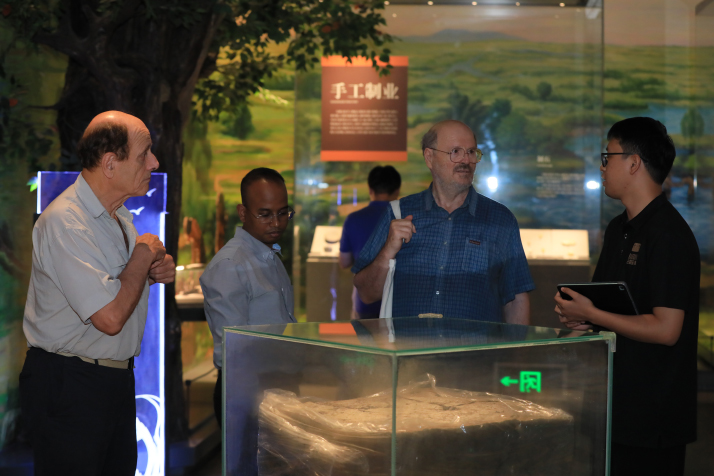| China |
| Chengdu honoring ancient roots while growing toward a tech-empowered future | |
|
|
 A staff member from Sichuan Jianshan Technology Co. Ltd. introduces the urban digital twin system to visitors on September 21 (COURTESY PHOTO)
Carl Crook, is a 74-year-old British-Canadian born in Beijing, who speaks Chinese as one of his native languages and has a deep appreciation for Chinese culture. He was among a group of eight foreign experts invited for an inside look at Glamorous Chengdu, an event organized by the Chengdu Municipal Bureau of Science and Technology and Chengdu Productivity Promotion Center. The Baodun Site and Baodun Culture Exhibition, their first stop on September 20, offered intriguing glimpses into the city's past through artifacts like pig skulls showing evidence of early domestication and ancient city wall ruins. According to the exhibition, the pig skulls, which date back 3,700-4,500 years, indicate the point in history at which Chengdu people had surplus crops to feed livestock. For Crook and his fellow visitors, it was a fascinating introduction to the longstanding agricultural roots of Chengdu, today's capital city of Sichuan Province. 'Heavenly Land of Plenty' In January 2022, the Baodun Site and Baodun Culture Exhibition opened to the public, unveiling the mysteries of the Neolithic Baodun culture that thrived 4,500 years ago in what is now Chengdu. Experts theorize this culture may be ancestrally linked to the later renowned Sanxingdui Culture, with some considering it the progenitor civilization. The sprawling Baodun City Ruins represent the earliest and largest prehistoric urban ruins unearthed on the Chengdu Plain. Particularly noteworthy is the rice-millet mixed farming and livestock husbandry system discovered in the Baodun culture, which laid the agricultural foundations of Chengdu and even Sichuan to some extent. This ancient region is known as "Tianfu Zhi Guo" in Chinese, literally meaning "Heavenly Land of Plenty." Carl's brother Michael Crook was also in the group. The brothers have a special connection to Chengdu, as their mother Isabel Crook, an anthropologist who made great contributions to English education in China throughout her life, was born in Chengdu in 1915. Michael was fascinated to learn that the 4,500-year-old ruins of Baodun's ancient city wall can still be seen today, and are situated amid rice paddies outside the museum. "I've been to Chengdu many times but this is my first time here. I just discovered that Sichuan's prehistoric civilizations include not only the renowned Sanxingdui Ruins, but also the even more ancient Baodun culture. It's really amazing!" exclaimed Michael Crook, reflecting on the expansive rice paddies ready for harvest below the Baodun ruins. Beyond primary industry If the Baodun ruins provide evidence of the origin of agriculture on the Chengdu Plain, then the Tianfu Agricultural Expo Park (TAEP), situated not far from the Baodun site in Chengdu's Xinjin District, provides a window into the future of agriculture. Containing exhibition halls, an agricultural science museum, agricultural technology demonstration areas, agricultural product trading centers and other facilities, the TAEP aims to serve as a platform to showcase innovations in agriculture and sustainability. As a national urban-rural integration development pilot zone and permanent home of the Sichuan Agricultural Fair, future agriculture is presented through the integration of agriculture and technology, and agriculture, culture and tourism across the park. At the center of the park, the five main venues have been designed under the concept of "hosting agricultural exhibitions on farmland." The complex incorporates agricultural features of the four seasons and traditional Chinese solar terms into its layout. According to the Guiding Opinions on Promoting Revitalization of Rural Industries released by the State Council in 2019, industry prosperity is an important foundation for rural revitalization and a prerequisite for solving problems in rural areas. At the TAEP, the prosperity and future prospects of agricultural industries are showcased through specific projects. The 200 hectares of demonstration farmland in the park exhibit applications of new technologies, including irrigation systems, crop growth monitoring stations and solar-powered bug zappers, are enabling agricultural intelligence. Additionally, the New Hope smart breeding base and Tongwei aquaculture photovoltaic integration project showcase balanced productivity and eco-friendliness through "smart hoggery plus whole industrial chain" and "photovoltaic generation plus modern fisheries" models respectively. "They told me the rice here is all organically grown, with over 300 varieties, some are experimental. And for harvesting, it's all mechanized. They also said they used to be villagers nearby. Since their fields are contracted by the TAEP, they're hired to work here with pretty good income. I think these agricultural developments and changes are great," Michael said after he walked into the rice field and chatted in Chinese with farmers weeding the fields.  A museum docent introduces the Baodun civilization to Carl Crook (second right) and other foreign experts at the Baodun Site and Baodun Culture Exhibition in Chengdu on September 20 (COURTESY PHOTO)
How 'Better Chengdu' is created In Chengdu, in both old and new districts, technological innovation and enablement have penetrated every step of urban development. The Wuhou International Urban Design Industry Center has undergone an impressive renewal. Originally the city government's office buildings constructed in 1993, it is now a hub for the digital creative industry, integrating green, low-carbon principles, urban design, digital technology and cultural creativity. As a model industrial cluster, the center offers facilities like one-stop industrial service centers, smart parking and rooftop gardens, providing convenient and comfortable experiences for enterprises. The renewal transforms outdated government buildings into a modern center promoting sustainability, innovation and creativity. Chengdu has provided a fascinating preview of the city's future development through its locally developed digital model of the city, known as the digital twin system. Created by Sichuan Jianshan Technology Co. Ltd., this advanced system presents Chengdu's urban architecture, landscapes and other aspects in centimeter-level detail. The model's futuristic style visualizes the city's growth and future trends with precision. By leveraging this innovative technology, Chengdu gives people a glimpse into the city's future evolution, showcasing its vision for urban planning and design. The system is an example of Chengdu's commitment to cutting-edge solutions for smart city development. Henry Radamson, a fellow of the European Academy of Sciences and researcher at the Guangdong Greater Bay Area Institute of Integrated Circuit and System was one of the foreign experts invited to visit the city. "Chengdu is a beautiful city with high potential for technology and business development," he remarked. Technological advancement and innovation depend on talent. It is the steady influx of domestic and international experts that accelerates Chengdu's development with ever more confident strides. "Chengdu is currently implementing a plan to attract high-level innovative and entrepreneurial talent, which is one part of our talent plans for industrial development," said Ding Xiaobin, head of the Chengdu Municipal Bureau of Science and Technology. "By continuously introducing new policies for talent recruitment, Chengdu is building solid long-term competitiveness in urban talent development." According to Ding, Chengdu's population has grown substantially over the past decade. The latest census data shows the city's net population increased by 5.8 million from 2011 to 2021. In just the last two years, Chengdu attracted 660,000 young workers, bringing its total workforce to over 6.2 million—ranking fourth nationwide. Chengdu has consistently been recognized as a top-tier city for talent attraction, and a most appealing destination in China for foreign experts. At a recent foreign experts' symposium in Chengdu, Matej Zima, a Slovenian scholar at Chengdu University, praised the city's livability. "With an extensive subway network, two international airports and rapid yet eco-friendly development, Chengdu has become a very convenient park city," he remarked. Zima highlighted that Chengdu offers an environment that draws professionals from around the world. For Zima, the city is not just a place to build his career, but also to put down roots—he has found love, started a family, and settled in Chengdu. "I'm proud to be one of the son-in-laws of this city," he proclaimed. (Print Edition Title: A City With Past and Future) Copyedited by G.P. Wilson Comments to zhaowei@cicgamericas.com |
|
||||||||||||||||||||||||||||||
|
